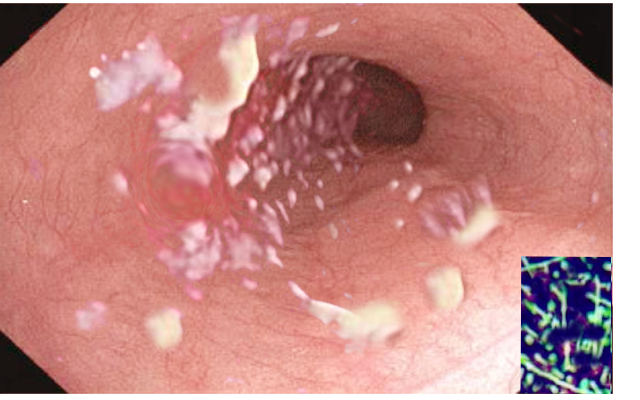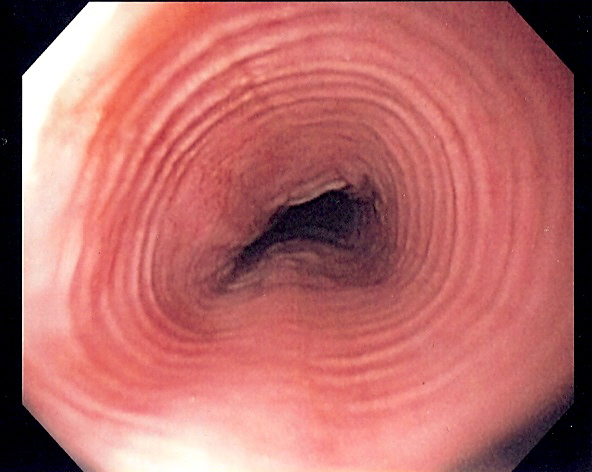[1]
Habbal M, Scaffidi MA, Rumman A, Khan R, Ramaj M, Al-Mazroui A, Abunassar MJ, Jeyalingam T, Shetty A, Kandel GP, Streutker CJ, Grover SC. Clinical, endoscopic, and histologic characteristics of lymphocytic esophagitis: a systematic review. Esophagus : official journal of the Japan Esophageal Society. 2019 Apr:16(2):123-132. doi: 10.1007/s10388-018-0649-1. Epub 2018 Oct 29
[PubMed PMID: 30370453]
Level 1 (high-level) evidence
[2]
Gomez Torrijos E, Gonzalez-Mendiola R, Alvarado M, Avila R, Prieto-Garcia A, Valbuena T, Borja J, Infante S, Lopez MP, Marchan E, Prieto P, Moro M, Rosado A, Saiz V, Somoza ML, Uriel O, Vazquez A, Mur P, Poza-Guedes P, Bartra J. Eosinophilic Esophagitis: Review and Update. Frontiers in medicine. 2018:5():247. doi: 10.3389/fmed.2018.00247. Epub 2018 Oct 9
[PubMed PMID: 30364207]
[3]
Hoversten P, Kamboj AK, Katzka DA. Infections of the esophagus: an update on risk factors, diagnosis, and management. Diseases of the esophagus : official journal of the International Society for Diseases of the Esophagus. 2018 Dec 1:31(12):. doi: 10.1093/dote/doy094. Epub
[PubMed PMID: 30295751]
[4]
Liacouras CA, Furuta GT, Hirano I, Atkins D, Attwood SE, Bonis PA, Burks AW, Chehade M, Collins MH, Dellon ES, Dohil R, Falk GW, Gonsalves N, Gupta SK, Katzka DA, Lucendo AJ, Markowitz JE, Noel RJ, Odze RD, Putnam PE, Richter JE, Romero Y, Ruchelli E, Sampson HA, Schoepfer A, Shaheen NJ, Sicherer SH, Spechler S, Spergel JM, Straumann A, Wershil BK, Rothenberg ME, Aceves SS. Eosinophilic esophagitis: updated consensus recommendations for children and adults. The Journal of allergy and clinical immunology. 2011 Jul:128(1):3-20.e6; quiz 21-2. doi: 10.1016/j.jaci.2011.02.040. Epub 2011 Apr 7
[PubMed PMID: 21477849]
Level 3 (low-level) evidence
[5]
Kim HP, Dellon ES. An Evolving Approach to the Diagnosis of Eosinophilic Esophagitis. Gastroenterology & hepatology. 2018 Jun:14(6):358-366
[PubMed PMID: 30166949]
[6]
Wang F, Li G, Ning J, Chen L, Xu H, Kong X, Bu J, Zhao W, Li Z, Wang X, Li X, Ma J. Alcohol accumulation promotes esophagitis via pyroptosis activation. International journal of biological sciences. 2018:14(10):1245-1255. doi: 10.7150/ijbs.24347. Epub 2018 Jul 13
[PubMed PMID: 30123073]
[7]
Ansari SA, Iqbal MUN, Khan TA, Kazmi SU. Association of oral Helicobacter pylori with gastric complications. Life sciences. 2018 Jul 15:205():125-130. doi: 10.1016/j.lfs.2018.05.026. Epub 2018 May 12
[PubMed PMID: 29763614]
[8]
Nejat Pish-Kenari F, Qujeq D, Maghsoudi H. Some of the effective factors in the pathogenesis of gastro-oesophageal reflux disease. Journal of cellular and molecular medicine. 2018 Dec:22(12):6401-6404. doi: 10.1111/jcmm.13939. Epub 2018 Oct 15
[PubMed PMID: 30320456]
[9]
Goyal A. Eosinophilic esophagitis: short and long-term considerations. Current opinion in pediatrics. 2018 Oct:30(5):646-652. doi: 10.1097/MOP.0000000000000662. Epub
[PubMed PMID: 30015687]
Level 3 (low-level) evidence
[10]
Davis BP. Pathophysiology of Eosinophilic Esophagitis. Clinical reviews in allergy & immunology. 2018 Aug:55(1):19-42. doi: 10.1007/s12016-017-8665-9. Epub
[PubMed PMID: 29332138]
[11]
DeBoer EM, Kinder S, Duggar A, Prager JD, Soden J, Deterding RR, Ruiz AG, Jensen EL, Weinman J, Wine T, Fortunato JE, Friedlander JA. Evaluating the yield of gastrointestinal testing in pediatric patients in aerodigestive clinic. Pediatric pulmonology. 2018 Nov:53(11):1517-1524. doi: 10.1002/ppul.24170. Epub 2018 Oct 4
[PubMed PMID: 30288952]
[12]
Ishimura N, Sumi S, Okada M, Mikami H, Okimoto E, Nagano N, Araki A, Tamagawa Y, Mishiro T, Oshima N, Ishihara S, Maruyama R, Kinoshita Y. Is Asymptomatic Esophageal Eosinophilia the Same Disease Entity as Eosinophilic Esophagitis? Clinical gastroenterology and hepatology : the official clinical practice journal of the American Gastroenterological Association. 2019 Jun:17(7):1405-1407. doi: 10.1016/j.cgh.2018.08.048. Epub 2018 Aug 23
[PubMed PMID: 30144524]
[13]
Huang KZ, Jensen ET, Chen HX, Landes LE, McConnell KA, Almond MA, Johnston DT, Durban R, Jobe L, Frost C, Donnelly S, Antonio B, Safta AM, Quiros JA, Markowitz JE, Dellon ES. Practice Pattern Variation in Pediatric Eosinophilic Esophagitis in the Carolinas EoE Collaborative: A Research Model in Community and Academic Practices. Southern medical journal. 2018 Jun:111(6):328-332. doi: 10.14423/SMJ.0000000000000817. Epub
[PubMed PMID: 29863219]
[14]
James C, Assa'ad A. The Global Face of Eosinophilic Esophagitis: Advocacy and Research Groups. Clinical reviews in allergy & immunology. 2018 Aug:55(1):99-105. doi: 10.1007/s12016-018-8683-2. Epub
[PubMed PMID: 29730731]
[15]
Ness-Jensen E, Hveem K, El-Serag H, Lagergren J. Lifestyle Intervention in Gastroesophageal Reflux Disease. Clinical gastroenterology and hepatology : the official clinical practice journal of the American Gastroenterological Association. 2016 Feb:14(2):175-82.e1-3. doi: 10.1016/j.cgh.2015.04.176. Epub 2015 May 6
[PubMed PMID: 25956834]
[16]
Jensen ET, Gupta SK. Early Life Factors and Eosinophilic Esophagitis: Building the Evidence. Journal of pediatric gastroenterology and nutrition. 2018 Nov:67(5):549-550. doi: 10.1097/MPG.0000000000002136. Epub
[PubMed PMID: 30211841]
[17]
Pan J, Cen L, Chen W, Yu C, Li Y, Shen Z. Alcohol Consumption and the Risk of Gastroesophageal Reflux Disease: A Systematic Review and Meta-analysis. Alcohol and alcoholism (Oxford, Oxfordshire). 2019 Jan 1:54(1):62-69. doi: 10.1093/alcalc/agy063. Epub
[PubMed PMID: 30184159]
Level 1 (high-level) evidence


